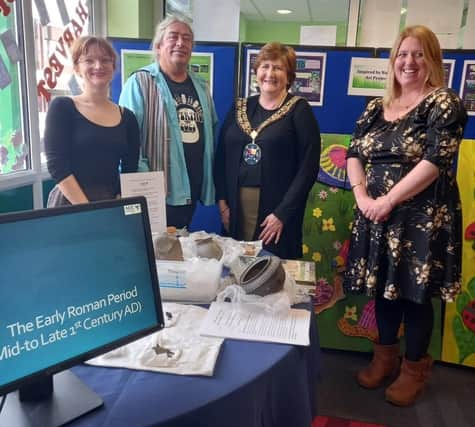Loss and Discovery book peels back the layers of Sandy’s fascinating history


The secrets of Sandy’s rich Roman and Anglo Saxon history continue to be uncovered by archaeologists on a fascinating dig on the outskirts of the town.
And residents were able to see some of the finds for themselves during a presentation at Sandy Library on October 7.
Advertisement
Advertisement
They learned about the results of a dig at the site of the planned expansion to the modern day cemetery at the launch of the AOC archaeologist group’s Loss and Discovery book to go with the work.
A previous dig had already established the site as a Roman settlement, so it was no surprise to the history hunters to find more evidence a little further north. Samples of the pottery, bones and jewellery were available for members of the public to examine.
The excavations, between April and November 2018, revealed new evidence regarding Roman and Saxon settlement and burial practices in the area between the 1st and 6th centuries AD. Of particular note was the discovery of a town ditch and a later town wall, the presence of which suggests that the Roman settlement that formerly occupied the site was more substantial than previously thought. The discovered Roman town wall is the first of its kind to be found in Bedfordshire.
Within the town wall, evidence of land division and road infrastructure were discovered, as were ovens, kilns and numerous pits spanning the mid-1st to 4th centuries AD. Outside the town wall, a cremation cemetery developed during the earlier part of the Roman period and a possible offering or midden pit was created during the 2nd century AD.
Advertisement
Advertisement
Another noteworthy find was the discovery of a Saxon-style sunken featured building and an early Saxon burial, carbon dated to the 6th century AD, the presence of which raises the possibility of unbroken occupation between the Roman and post-Roman periods in the vicinity of the site. It is planned that the human remains will be reinterred into the new cemetery.
Becky Haslam, AOC Project Manager, added: “The excavation of the cemetery extension has really changed our view of what Sandy was like in the Roman period. The presence of a masonry town wall was entirely unexpected and demonstrates that the settlement was far more significant than we thought previously. It was wonderful to be given the opportunity to present the results of such an important excavation to the local community, to showcase some of our best finds and to launch an e-book about our discoveries, which can be downloaded for free from the AOC Archaeology website https://www.aocarchaeology.com/publications/sandy. The whole team would like to extend our thanks to Sandy Town Council, who generously funded the excavation and the publication of the book.”
Sandy Town Council has a permanent exhibition of Roman finds from previous excavations at its offices in Cambridge Road. They are available for the public to visit.
And plans are in the final stage of approval for the layout of the cemetery extension.